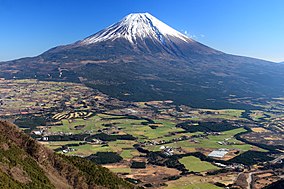| Fuji-Hakone-Izu National Parks | |
|---|---|
| 富士箱根伊豆国立公園 | |
 Mount Fuji | |
| Location | Central Honshu, Japan |
| Coordinates | 34°40′N 139°0′E / 34.667°N 139.000°E |
| Area | 1,227 km2 (474 sq mi) |
| Established | February 1, 1936 |
| Governing body | Ministry of the Environment |
Fuji-Hakone-Izu National Park (富士箱根伊豆国立公園, Fuji-Hakone-Izu Kokuritsu Kōen) is a national park in Yamanashi, Shizuoka, and Kanagawa Prefectures, and western Tokyo Metropolis, Japan. It consists of Mount Fuji, Fuji Five Lakes, Hakone, the Izu Peninsula, and the Izu Islands. Fuji-Hakone-Izu National Park covers 1,227 square kilometres (474 sq mi).[1]
Rather than being a specific spot, the park is a collection of dispersed tourist sites that dot the region. The farthest point south, the isle of Hachijō-jima, is several hundred kilometers from Mount Fuji. The park includes a variety of geographic features including natural hot springs, coastlines on the Pacific, mountainous areas, lakes, and more than 1,000 volcanic islands. Vegetation in the park ranges from species of mountainous trees to the subtropical vegetation of the Izu Islands.[1][2]
Fuji-Hakone-Izu National Park was established on February 2, 1936, as Fuji-Hakone National Park, and is one of the first four national parks established in Japan. In 1950, the Izu islands were added to the park, a change that also reflected in the park's revised name. Due to its proximity to the Tokyo metropolis and ease of transportation, it is the most visited national park in all of Japan.[3]
Nearby cities include Odawara, Fuji, Minami Ashigara, and Numazu.
- ^ a b "Fuji-Hakone-Izu National Park". Encyclopedia of Japan. Tokyo: Shogakukan. 2012. OCLC 56431036. Archived from the original on 2007-08-25. Retrieved 2012-08-13.
- ^ "Fuji-Hakone-Izu National Park". Tokyo: JP Co., Ltd. 2006. Archived from the original on 2012-06-23. Retrieved Aug 13, 2012.
- ^ "Mount Fuji". Washington, D.C.: National Geographic Society. c. 2012. Archived from the original on January 8, 2012. Retrieved Aug 13, 2012.

